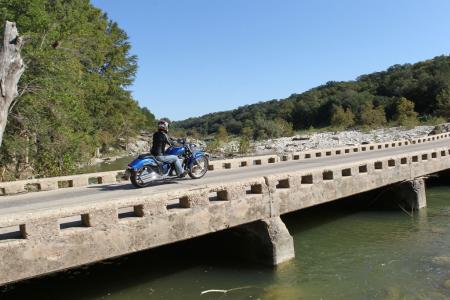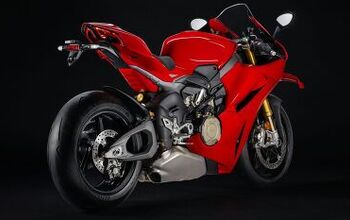Church of MO: 2011 Star Stryker Review
I actually didn’t mind being seen on this “custom cruiser” ten years ago. Yamaha’s answer to the Honda Fury had the chopper look and sound, but offset triple clamps and a revvable, oversquare 1312cc V-twin with four-valve heads made it also a functional, fun-to-ride motorcycle. America must’ve agreed; a quick run through Cycle Trader finds prices about twice what I would’ve expected for a ten-year old Japanese cruiser. Or maybe Yamaha’s marketing ploy worked? It’s a STAR, man!
A solid stryke for Star!
According to Star Motorcycles, it remains king of the hill among metric cruisers (might as well lump Victory in there) in America. Since 2007 the Yamaha sub-brand has maintained its position as “the second most recommended brand,” coming in behind you know who (Harley).Contributing to Star’s success is its big-bore custom-style Raider, winner of our Mainstream Chopper Shootout. The turnkey custom theme seems a safe bet these days.Industry data provided by Star shows that 73% of the mid-size cruiser segment consists of custom-style cruisers. We only have to look to Honda’s surprisingly popular Fury as some hard evidence to support this data.
In light of the custom domination, and building on the groundwork laid by the Raider, Star saw a perfect opportunity to fill a gap in its mid-size cruiser lineup by creating the Stryker.
This newest Star is powered by an 80-cubic-inch liquid-cooled, four-valve-head, SOHC, fuel-injected 60-degree V-Twin. With a few exceptions, like a larger airbox, new ECU and reconfigured EFI, the Stryker’s lump is largely the same as the Twin that motivates the V Star 1300.
This mid-size Star engine gets its 1304cc displacement through an unusually oversquare bore and stroke (100mm x 83mm) for a cruiser. Conversely, Honda’s VTX 1300 (powering the Fury) uses an 89.5mm bore and 104.3mm stroke to achieve its 1312cc size. Also, the Star uses a belt drive to transfer power to the rear. A belt final-drive isn’t as virtually maintenance-free as the shaft final-drive the Fury utilizes, but belt drive is lighter and allows for easier customization.
An all-new cradle-type steel frame was crafted to carry the 1300.Although the single-pin crankshaft engine is rigid-mounted in the new frame, dual counter balancers in the engine offset vibes, yet not so much to entirely mute the power pulse feel inherent in a single-pin crank. That lumpity-lump sensation (and resulting burly exhaust note) is very influential on riders partial to V-Twins.
Since styling is the linchpin for custom cruiser appeal, Star designers knew that a raked-looking front-end was elemental to the Stryker’s look.
In order to achieve the desired chopper look without sacrificing good handling qualities, a 6.0-degree offset triple clamp is matched to a 34.0-degree steering head angle for an effective steering rake of 40 degrees. This set up results in 109mm of trail – a figure that offers decent compromise between stability and quick-ish cruiser handling.
The Stryker’s cast aluminum rear wheel is on loan from the Raider and carries a 210/40-18 tire; a 310mm rotor and single-piston brake caliper also reside out back.
Like the importance of that raked front-end look, Star also knew a big, airy front wheel is integral to the chopper/custom design, and so a 21-inch wheel spins at the end of the preload-adjustable 41mm fork.This big front hoop, however, doesn’t ride on the customary skinny tire. To help aid solid handling, Star instead used a 120/70-21 front tire where a pizza cutter 110 – or sometimes even a 90 – section tire is often found on custom-type bikes.
Although the Stryker’s front wheel looks a whole lot like the front wheel on the Raider, it is in fact different since a single 320mm rotor is attached to it, whereas the Raider employs dual 298mm rotors. Bridgestone Exedra tires grace the Stryker’s wheels.
According to Star, the Stryker boasts the lowest seat height in the Star line at 26.4 inches, while its rider triangle is a bit more open than the V Star’s ergos.
An all-new handlebar-mounted instrument gauge departs from the common custom bike theme of placing the gauge(s) on the fuel tank. The Stryker’s gauge consists of an analog speedo, the usual array of warning lights and an inset LCD offering two trip meters, clock, odometer and fuel gauge.
For ease-of-use, the LCD’s selector and reset buttons are both located on the right-side switchgear housing.
| Spec sheet jockeying the Star Stryker and Honda Fury | ||
| Stryker $10,990 base price | Fury $12,999 base price (2010) | |
| Engine | 1304cc (100.0 x 83.0), l-c, SOHC, 4-valve per 60-degree V-Twin with 5-spd and belt final-drive | 1312cc (89.5 x 104.3), l-c, SOHC, 3-valve per 52-degree V-Twin with 5-spd and shaft final-drive |
| Chassis: | Steel double cradle frame; 41mm fork w/5.3” travel; single shock w/3.9” travel | Steel double cradle frame; 45mm fork w/4.0” travel; single shock w/adjustable rebound damping, 5-pos preload adjustment and 3.7” travel |
| Brakes | Front — single 320mm disc w/two piston sliding-pin caliper Rear – single 310mm disc w/one piston sliding-pin caliper | Front — single 336mm disc w/two piston sliding-pin caliper Rear – single 296mm disc w/one piston sliding-pin caliper |
| Tires: | Front – 120/70-21 Rear – 210/40-18 | Front – 90/90-21 Rear – 200/50-18 |
| Dimensions | Seat height – 26.4” Wheelbase – 68.9” Steering rake – 34.0-degrees (40.0 w/6.0 offset triple tree) Trail – 4.29 Fuel capacity – 4.0 gal Claimed wet weight – 646 lbs | Seat height – 26.7” Wheelbase – 71.2” Steering rake – 32.0-degrees Trail – 3.5” Fuel capacity – 3.4 gal Claimed ready-to-ride curb weight – 663 lbs |
It’s easy to draw parallels in styling between the Raider and Stryker, but a noteworthy difference is the Stryker’s more rounded 4.0-gallon fuel tank – a shape Star purposely chose in order to help create a muscular stance for the Stryker. Also, the Stryker’s various chrome pieces sport a “revolver split pattern,” a look reminiscent of the scoops on a six-shooter’s cylinder.
Chicken-fried Stryker
Along with some of the best chicken-fried steak, BBQ beef ribs and fried catfish in the country, the Austin, Texas area is also known for its rolling hills topography, more affectionately referred to as Hill Country. Music is pretty popular here, too (wink).
A circuitous 125-mile route that included some urban and freeway stints, but consisted mostly of meandering two-lane country roads winding their way over softly undulating hills and into shallow valleys in this lusher-than-expected part of Texas served as the testing grounds.
Saddling up to the Stryker I was quickly impressed by an ergo package as comfortable as Star staffers claimed.
Reach to the handlebar and forward foot controls felt natural for my 5-foot, 8-inch frame and 30-inch inseam; and the deeply contoured saddle did a good job of holding me in place. Also, I was grateful that the ergos did not position me so that my hips rotated forward. I sat squarely on my bum rather than on my tailbone, and seat foam density was supportively firm.
Of course, fit and feel in the first 15 miles of a ride is often a different experience than at the 120th mile.
However, overall ride comfort was consistent throughout the day, and the unfaired fists-in-the-wind position didn’t result in excessive windblast or buffeting. Even a much taller, 6-foot, 2-inch rider agreed with my favorable assessment of the Stryker’s rider triangle.
Lending greatly to the Stryker’s pleasant ride is a well-balanced suspension package that offered better-than-expected damping from both the shock and fork.
Road surfaces were in excellent condition, so a run through rutted urban streets or choppy highway pavement may reveal some harsh hits from the fork or shock. But I’ve no reason to think the Stryker’s overall good ride quality would diminish much when ridden over crummy roads.
Steering effort was, at worst, minimal, especially for a bike with a fat 210 rear tire, and 21-incher up front.
The Stryker never exhibited the “chopper flop” common in custom bike handling. It was quite the opposite, actually, with notably linear motion from upright to the gentle angles most cruisers need to complete a turn. The Stryker stayed on course perfectly throughout turns, and ground clearance was greater than expected. Only aggressive, quick turning resulted in touching a footpeg feeler.
Another welcome surprise was the amount of thrust the 1300cc Vee generated.
Dumping the clutch and slamming the throttle open in first gear gets the big rear tire spinning quickly, leaving a smoky black streak without much effort. And although gearing in the 5-speed box feels quite tall (top gear feels like overdrive), the engine ably pulls the tall gearing.
Carrying two gears higher than necessary means lugging the engine, but the Twin pulls cleanly if you’re one gear too high, even if it’s a quick downshift from 5th to 4th at slower speeds.
Additionally, some driveline lash is apparent, but mostly when transitioning from a closed to open throttle. Shifting action was of typical modern Japanese motorcycle quality, and fueling seemed perfect with no hesitation in throttle response.
Hauling down a bike with a claimed wet weight of 646 lbs sounds like the job for some serious binders. The Stryker’s humble brake package was easily up to task, with decent feel from the style-conscious single caliper/rotor combo in front.
Take it to the LimitsIf you can make it here, you can make it anywhere. No, we aren’t talkin’ The Big Apple, but rather the state capital of Texas: Austin.
As an aspiring musician, band, singer or songwriter, it’s not Hollyweird or Nashville you should bookmark on your GPS; instead make a beeline for The Live Music Capital of the World (Austin is so serious about that slogan, it’s a registered mark).
According to the Austin Convention and Visitors Bureau website, this little big town is home to some 200 venues that host a continual influx of performers. From those climbing the first rungs of their musical dream ladder to legendary pillars of the music world, Austin seems to have a stage for all of them.
A quick stroll down Sixth Street leaves little reason to suspect the 200-venue claim is an exaggeration. It seems every other doorway in the Sixth Street District (one of six districts within the heart of Austin) leads to a nightspot or bar wherein live music resonates and spills out the open windows and doors, wooing passersby like aural incense.
Perhaps best defining Austin as a music town is the Public Broadcasting System staple: Austin City Limits.
ACL has broadcast (previously recorded) live performances from Austin for 35 years. From modern mainstream rock bands to quirky, relatively unknown one-man-shows, chances are ACL (austincitylimits.org) had ‘em on the air.
For those of you more in tune than some of us, you’ll already know that Austin is home of South By Southwest ( sxsw.com), a sprawling multi-day music festival.SXSW started in 1987 with 700 acts. It now boasts upwards of 12,000 registered music makers, and also includes conferences for the film and interactive media industries.
One evening as I roamed Sixth Street in search of a cold one and a live show, a thought struck me like powerful vibes from a full volume bass riff: Austin seems like the toughest place in the world to make a name for yourself as a music act.
It was at Friend’s Bar that I met singer/songwriter Philip Q. Morrow and his three band mates. I couldn’t resist asking them what it’s like as performers striving for musical acclaim in Austin.
“Austin is a beautiful city to live in first of all,” said acoustic guitarist and lead vocal Morrow. “[As a musician] it’s great to live here. There’s such a great support group, because everyone’s a musician.”
However, Morrow also recognizes the drawbacks of a large community of like-minded artists: “But then … everyone’s a musician.”For sources of musical and lyrical influences, Morrow points to John Mayer and the Dave Matthews Band. But as a native of West Texas – where country music apparently has strong roots – Morrow said the country music genre imposes on his craft as well.
With songs composed primarily on acoustic guitar, Morrow’s singing, songwriting and playing exhibits “a youthful adult-contemporary sound that treads familiar territory but with a current vibe,” says Motorcycle.com’s own Kevin Duke, a bona fide music critic in another life.
Not only are Morrow and his band affable and talented fellows, they’re also troopers for trying to make it in The Live Music Capital of the World.
– Pete Brissette
(See if your ear agrees – or not – with Duke’s seasoned sound intake tubes by checking out Philip Q. Morrow’s music at www.reverbnation.com/philipqmorrow.)
A solid stryke!
As the Stryker is something of a price-point model, a few sacrifices must be made, like the many chrome pieces crafted from plastic rather than metal. And control cables routed externally rather than internally rob the rider of a clean, unencumbered view over the handlebar to the headlight.
However, as part of Star’s cruiser philosophy, all Star models sport metal fenders. Not every budget-conscious Japanese cruiser can make that claim.
Along with perceived higher quality offered from the metal fenders, I also appreciated the LCD selector and reset button located in one spot. I wasn’t so keen, though, on the odd characters for the fuel gauge: EooooF. At first I thought it was some type of error code. A simpler set of graduating bars or something might’ve been more intuitive.
These nits aside, Star has a well-heeled, sufficiently powered, all-around good performer in the new Stryker.
Despite not appearing as cleanly styled as Honda’s Fury, the Stryker should otherwise turn heads with a base MSRP $2K cheaper than the 2010 Fury (Honda has yet to announce 2011 Fury pricing).
Pricing for the 2011 Star Stryker is $10,990 for the blacked-out Raven model and $11,240 for the Impact Blue or Reddish Copper colors.
Related Reading
2008 Star Raider Review
2010 Honda Fury Review
2007 Star V Star 1300 Review
Mainstream Choppers Shootout
All Things Cruiser on Motorcycle.com
All Things Yamaha on Motorcycle.com
More by John Burns








































Comments
Join the conversation
Am I the only one who's disappointed that Japanese brands have essentially abandoned the large displacement v-twin market? I'm in the market for a new V-Twin touring model, and Harley and Indian are basically the only two choices nowadays. At 20K plus, it's getting silly. The new Road King is nicer than my 2006 Nomad, but barely. I think it's time to buy a warehouse and scoop up as many VTXs, Roadliners, Vulcans, Star 1300s as possible, refurbish them, and provide them as a viable alternative.
That only thing that ruins this bike, besides it looking a little dated, is the tank seam. Why oh why do the Japanese resist hiding tank seams on cruisers?